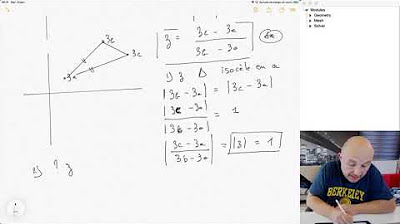UTBK 2025 QUESTIONS MATHEMATICAL REASONING
Summary
TLDRIn this detailed educational video, the presenter guides UTBK 2025 test-takers through complex mathematical reasoning problems, focusing on volume calculations and geometric relationships involving cones of sand. The script provides step-by-step solutions to various problems, helping students better prepare for the UTBK exam. The presenter emphasizes the importance of practice, offers practical tips for problem-solving, and encourages students to engage actively with the material. Throughout the video, the speaker also promotes additional learning resources and online classes to further support students' exam preparation.
Takeaways
- 😀 Mathematical reasoning is the most challenging part of the UTBK, especially when it comes to problems involving cone volumes and ratios.
- 😀 Practice is crucial for mastering UTBK math problems. Repetition of model questions helps improve performance.
- 😀 Cones and their volume formulas (1/3 * π * r² * h) play a significant role in solving many math reasoning questions.
- 😀 The relationships between variables, like the radius and height of cones, are key to simplifying and solving problems.
- 😀 When the volume flow rate is the same for two cones, their volumes are equal, and this concept is central to many questions.
- 😀 Understanding how to manipulate and simplify equations (like canceling terms) makes solving complex math problems easier.
- 😀 The relationships between different parts of the cones (e.g., radius and height) help reduce the problem to simpler forms.
- 😀 Regular training and tryouts based on real UTBK problems are essential for success in the exam.
- 😀 Preparing for UTBK involves both theoretical learning and practical exercises. It’s essential to practice problem-solving and analysis.
- 😀 Using visual aids like diagrams is a helpful strategy for understanding mathematical relationships and solving problems effectively.
- 😀 Success in UTBK requires persistence and dedication, with tools like books, online classes, and practice tests playing an important role.
Q & A
What is the main topic of the video?
-The main topic of the video is discussing and solving mathematical reasoning problems for the UTBK 2025 exam, specifically focusing on cone-shaped sand volume problems.
What is the mathematical formula mentioned for calculating the volume of a cone?
-The formula for the volume of a cone mentioned in the video is: Volume = (1/3) * π * r^2 * h, where r is the radius of the base and h is the height of the cone.
How is the relationship between the radius and height of the two types of sand described in the problem?
-For sand A, the radius of the base (ra) is half the height (ta), meaning ra = 1/2 * ta. For sand B, the radius of the base (rb) is equal to its height (tb), meaning rb = tb.
What is the significance of the volumes of sand A and B in the problem?
-The volumes of sand A and B are equal because the sand is poured at the same volume rate, and the problem asks to find the relationship between their radii or heights based on their volume equality.
What is the key approach to solving the problem of the ratio of radii (ra and rb)?
-The problem uses the volume formula for each cone, simplifies the expression, and compares the radii by eliminating common factors to derive the ratio ra/rb = √(1/2).
What mathematical operations were used to simplify the volume equation?
-The video demonstrates simplifying the equation by canceling out common factors like π and (1/3), then substituting known relationships between the radii and heights (ra = 1/2 * ta and rb = tb) to solve the equation.
How did the instructor suggest handling similar UTBK reasoning problems?
-The instructor recommended practicing regularly, doing try-outs, and familiarizing oneself with the specific problem formats found in past UTBK exams to develop problem-solving skills.
What concept from high school geometry was applied to solve the sand volume problem?
-The concept of the volume of cones was used, along with algebraic manipulation to express the relationship between the radii and heights of the sand piles in terms of each other.
How does the instructor advise students to prepare for the UTBK exam in terms of their study habits?
-The instructor advises students to study consistently, take practice tests (try-outs), and review model problems, especially focusing on developing mathematical reasoning skills.
What is the answer to the ratio of the radii (ra and rb) in the sand volume problem?
-The ratio of the radii, ra to rb, is √2, as derived from the equation ra/rb = √(1/2).
Outlines

هذا القسم متوفر فقط للمشتركين. يرجى الترقية للوصول إلى هذه الميزة.
قم بالترقية الآنMindmap

هذا القسم متوفر فقط للمشتركين. يرجى الترقية للوصول إلى هذه الميزة.
قم بالترقية الآنKeywords

هذا القسم متوفر فقط للمشتركين. يرجى الترقية للوصول إلى هذه الميزة.
قم بالترقية الآنHighlights

هذا القسم متوفر فقط للمشتركين. يرجى الترقية للوصول إلى هذه الميزة.
قم بالترقية الآنTranscripts

هذا القسم متوفر فقط للمشتركين. يرجى الترقية للوصول إلى هذه الميزة.
قم بالترقية الآنتصفح المزيد من مقاطع الفيديو ذات الصلة
5.0 / 5 (0 votes)






